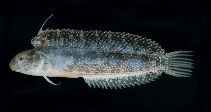| Family: |
Blenniidae (Combtooth blennies), subfamily: Blenniinae |
| Max. size: |
13 cm TL (male/unsexed) |
| Environment: |
benthopelagic; brackish; marine; depth range 1 - 10 m |
| Distribution: |
Western Pacific: Queensland, New South Wales, Lord Howe Island, Australia and New Caledonia. |
| Diagnosis: |
Dorsal spines (total): 11-11; Dorsal soft rays (total): 19-20; Anal spines: 2-2; Anal soft rays: 18-20. Jaw teeth incisiform, rigid, close-set, increasing with age; large, curved canine tooth on each side at posterior of lower jaw, and smaller canine on each side at posterior of upper jaw (similar dentition shared within genera); lower end of gill opening above level of pectoral-fin base (also a shared character within genera); small unbranched cirrus on each side of chin; with or without small supraorbital and nuchal cirri; body depth at anal-fin origin 4.5-7.0 SL; males with elongated second dorsal spine; unnotched dorsal fin; caudal fin interradial membranes slightly incised, notably in males; ground color variable with habitat, gray, brown, or green, with 6 large, uneven dark blotches on upper side and numerous white dots and dashes and, ventrally, dark dots. Anal soft rays rarely 18; pectoral soft rays typically 14; segmented caudal rays 1, unbranched (Ref. 54980). |
| Biology: |
Adults hide in seagrasses, seaweeds, or empty mollusk shells. Oviparous (Ref. 205). Mature females lay eggs on the inner surface of dead bivalve shells which are guarded by the male (Ref. 2334). Larvae are planktonic, often found in shallow, coastal waters (Ref. 94114). |
| IUCN Red List Status: |
Least Concern (LC); Date assessed: 25 March 2009 Ref. (130435)
|
| Threat to humans: |
harmless |
Source and more info: www.fishbase.org. For personal, classroom, and other internal use only. Not for publication.
